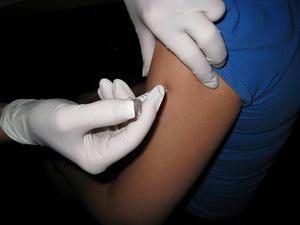H1N1: what you need to know
(Image: Flickr user lulu (cc: by-nc-sa))
The following is a partial transcript; for full story, listen to audio.
By early next week, the first batch of some 250 million swine flu vaccine treatments will be available free, paid for by the American government. In an unprecedented preventive campaign, health officials are trying to blunt the impact of the H1N1 virus, or swine flu, as it’s commonly called.
But symptoms are described as a mild influenza. Is the public overreacting? Is the media getting the story right? What does the public need to know? What do we need to do?
Jeffrey Kahn, Chief of Infectious Diseases at the Children’s Medical Center in Dallas, has seen a “dramatic” increase in the number of children sent to the hospital’s emergency room. However, he says, not many of them are actually admitted to the hospital.
Dr. Kahn and his team are conducting selective screenings for H1N1, testing only those children who are considered high risk for influenza — children who are under two years of age and children who have an underlying medical condition, like asthma.
He says the children who have H1N1 but are not considered high-risk are treated symptomatically, while the high-risk children are treated with anti-viral medication, like Tamiflu.
According to Dr. Kahn, the symptoms and severity he’s seeing are almost identical to seasonal influenza, but he thinks precaution still needs to be taken, as the rate at which H1N1 is spreading is rapid.
“Influenza viruses are predictably unpredictable, and we know this from past influenza pandemics,” said Dr. Kahn. “The virus that we’re dealing with right now tends to cause mild diseases, as I’ve already mentioned. But we’re seeing it spread very rapidly through the community, and that’s not surprising because there’s very little immunity to this virus in the general population, so there’s nothing to stop the virus from spreading rapidly.”
Amanda Ripley, a contributor to “Time Magazine,” believes the media is partly responsible for helping the public navigate the uncertainty around H1N1. She admits this is difficult as the public is looking for answers.
She says to follow the example of the many experts and medical professionals she’s talked to: “Try to stay habitually informed by checking different kinds of sources.”
She adds that so far, the H1N1 scare has been managed well: “I’ve covered disasters for ‘Time’ and I have to tell you, compared to the vast majority of potential catastrophes and actual catastrophes that I’ve written about, the CDC and the public health institutions in America in general, have handled this in a much more sophisticated and transparent fashion than other government agencies.”
Ripley believes the labeling of H1N1 as a pandemic by the World Health Organization, “based on the geographic thread, not the severity of the threat,” caused unnecessary panic in the public.
Dr. Georges Benjamin is Executive Director at the American Public Health Association. He says since H1N1 is a respiratory disease, the things people can do to protect themselves are the same things they would do to avoid catching a cold: washing their hands, covering their noses and mouths when they cough or sneeze, and staying away from people who are already sick.
He explained how our bodies recover from influenza: “Your body has an immune response, and anytime you’re exposed to a new organism, if you’ve seen that organism before, your body has a very rapid response to it. If you haven’t seen that organism before, your body will … have to gin up a bit to respond to it.
“That’s what vaccines do. Vaccines fool your body into thinking that you’ve actually had the infection already so that you can have a very rapid response when you see that virus again.”
His recommendation: “I would encourage people to recognize that vaccination is the single most important preventative measure we have against influenza. And I would encourage people to get vaccinated, certainly those in the high-risk groups should get in front of the line. But influenza comes every year, and this is not a one-year challenge, and they should plan for it every single year.”
Hosted by award-winning journalist Warren Olney, “To the Point” presents informative and thought-provoking discussion of major news stories — front-page issues that attract a savvy and serious news audience.
